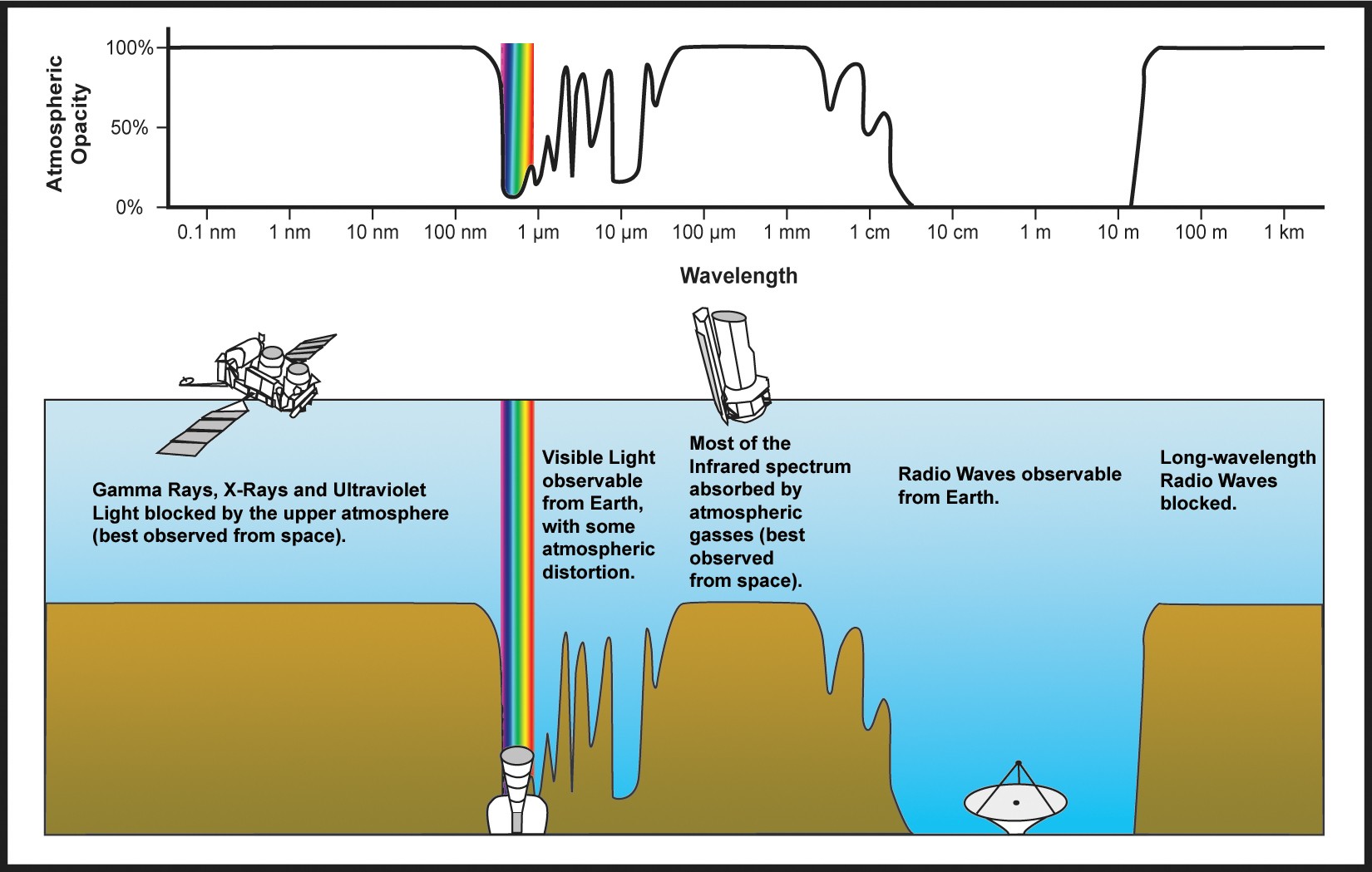
On this diagram, why is the atmospheric opacity shaped as it is?
If we are able to see lights due to low atmospheric opacity, why can't we see radio waves, when the atmospheric opacity is so low for these kinds of waves?
What does the author mean by "observable"?
Answer
On this diagram, why is the atomspheric opacity shaped as it is?
Different parts of the atmosphere are responsible for the shape of that curve. Electromagnetic radiation impinging on some object can be reflected by the object, absorbed by the object, or transmitted through the object. An ideal black body absorbs all incoming radiation, regardless of wavelength. A real body such as our atmosphere behaves differently from a black body. The behavior of a real body oftentimes varies with frequency. That certainly is the case with our atmosphere.
The shortest wavelengths (extreme ultraviolet, X-rays, and gamma radiation) of radiation have enough energy per photon to eject electrons from atoms and molecules. This is ionizing radiation. Any atom or molecule that gets in the way of an incoming short wavelength photon can that photon. The atmosphere looks like a thick lead plate at these high wavelengths. Ionizing radiation (wavelengths of about 100 nm or less) occupy the far left of the graphic that you posted.
Longer wavelength ultraviolet light is not ionizing, but it can cause chemical reactions to occur. Unfortunately for us, some of the chemical reactions caused by UV radiation can lead to skin cancer. Fortunately for us, ultraviolet light reacts in a rather interesting way with oxygen. The ozone layer absorbs the vast majority of the incoming ultraviolet light.
Thanks to the absorption of very high wavelength radiation by the upper atmosphere and the absorption of ultraviolet light by the ozone layer, very little of the most damaging kinds of electromagnetic radiation make it through our atmosphere. In contrast to that almost complete absorption of short wavelength radiation, our atmosphere is rather poor at absorbing visible radiation and short wavelength infrared radiation. This is the "visible window." This visible window also represents the peak of the energy output from our sun. This is a happy coincidence that is essential to life as we know it.
Light at longer wavelength infrared radiation interacts with various vibrational modes of multi-atomic molecules. These interactions result in the multiple peaks and valleys in your graphic between 1 and 30 µm. The atmosphere is a very good absorber of even longer wavelengths, 30 µm to 30 mm. Another series of vibrational interactions take place between 30 mm and 30 cm, resulting in another suite of peaks and valleys in that graphic.
The atmosphere is more or less transparent to radiation with a wavelength between 30 cm and 10 meters. These longer wavelengths represent another window to the universe, the radio window. This window closes at very long wavelengths. The ionosphere reflects that very long wavelength radiation back into space.
Why can't we see radio waves, when the atomspheric opacity is so low for these kinds of waves?
Most animals, including humans, don't "see" radio waves because there's a reduced biological imperative to be able to do so. The ability to sense visible radiation is very important thanks to that happy coincidence of a visible window and peak solar output. That said, some animals have developed the ability to "see" radiation at wavelengths other than visible light. A number of insects and birds can see into the ultraviolet range. Pit vipers can "see" thermal infrared. Sharks can "see" extremely long wavelength radiation thanks to their lateral lines.
What does the author mean by "observable"?
Those places in the electromagnetic spectrum where the atmosphere doesn't absorb or reflect incoming radiation are our land-based windows to the universe. We can't build ground-based instruments that see gamma radiation, X-rays, or infrared radiation. The atmosphere absorbs radiation of those wavelengths. The only way to "see" the universe at those wavelengths is via satellites that orbit well above the Earth's atmosphere.
No comments:
Post a Comment